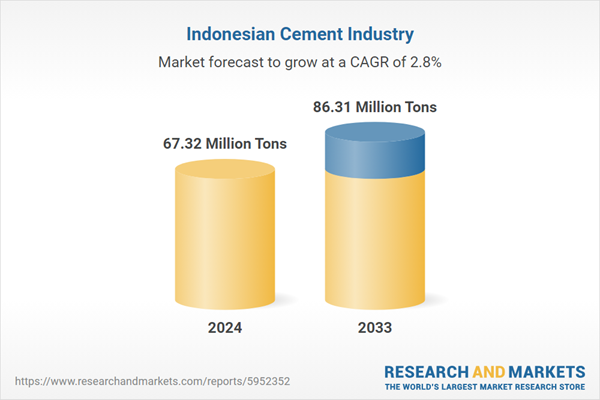Indonesia has emerged as the sixth-largest cement producer globally, with an estimated production of 66 million metric tons in 2023. Despite the challenges posed by the pandemic, its impact on the country's cement industry has been relatively moderate. Infrastructure and residential-commercial projects have played a crucial role in sustaining domestic demand during this period.
However, cement consumption remains low in Indonesia, with per capita annual production at no more than 300 kilograms, significantly lower than that of its peers like Malaysia (over 600 kilograms per capita) or Vietnam. According to the publisher, this suggests that infrastructure development is still lacking in Southeast Asia's largest economy. The insufficient quality and quantity of infrastructure hinder connectivity, raise logistics costs, reduce business competitiveness, and contribute to social issues, such as limited access to healthcare in rural regions.
The ongoing development of Indonesia's new capital city, IKN, particularly in Sumatra and Eastern Indonesia, has stimulated demand for cement. Leading companies like Semen Indonesia have shifted their focus to the domestic market, capitalizing on improved coal supplies availability in the first half of 2022.
Looking ahead, the cement sector expects significant growth driven by demand from developers undertaking numerous new construction projects, including the construction of a new capital in Borneo Island's jungles. Moreover, Indonesia's ambitious plans for sustained economic growth, with numerous seaports and harbor projects in the pipeline, alongside increasing urbanization, indicate Indonesia will remain a construction hub for years.
However, concerns loom over the industry, including rising production costs, particularly energy-related issues, and worries about the environmental impact of cement production, with instances of local unrest around provincial plants. Furthermore, Indonesia is still grappling with overcapacity in the cement sector, with a utilization level of 54% in 2022 and no expected increase beyond 57% by 2025.
In conclusion, Indonesia's cement industry is expected to have a moderate expansion despite encountering challenges such as fluctuating energy prices, environmental concerns and overcapacity. The publisher projects that the production volume of Indonesia's cement industry will rise from 67.32 million metric tons in 2024 to approximately 86.31 million metric tons by 2033, exhibiting a compound annual growth rate (CAGR) of 2.8%.
Topics covered:
- Indonesia Cement Industry Overview
- Economic environment and policy environment of cements in Indonesia
- Indonesian cement market size from 2019 to 2023
- Analysis of major Indonesian cement manufacturers
- Key Drivers and Market Opportunities of Indonesia’s Cement Industry
- What are the key drivers, challenges and opportunities for the Indonesian cement industry during the forecast period 2024-2033?
- What is the expected revenue of the Indonesia Cement market during the forecast period 2024-2033?
- What strategies are adopted by the key players in the market to increase their market share in the industry?
- Which segment of the Indonesian Cement Market is expected to dominate the market in 2033?
- Indonesia Cement Market Forecast from 2024 to 2033
- What are the main headwinds facing Indonesia’s cement industry?
Table of Contents
Companies Mentioned
- Semen Indonesia
- Indocement Tunggal Prakarsa
- Holcim Indonesia
- Holcim-Apasco
- Conch
Methodology
Background research defines the range of products and industries, which proposes the key points of the research. Proper classification will help clients understand the industry and products in the report.
Secondhand material research is a necessary way to push the project into fast progress. The analyst always chooses the data source carefully. Most secondhand data they quote is sourced from an authority in a specific industry or public data source from governments, industrial associations, etc. For some new or niche fields, they also "double-check" data sources and logics before they show them to clients.
Primary research is the key to solve questions, which largely influence the research outputs. The analyst may use methods like mathematics, logical reasoning, scenario thinking, to confirm key data and make the data credible.
The data model is an important analysis method. Calculating through data models with different factors weights can guarantee the outputs objective.
The analyst optimizes the following methods and steps in executing research projects and also forms many special information gathering and processing methods.
1. Analyze the life cycle of the industry to understand the development phase and space.
2. Grasp the key indexes evaluating the market to position clients in the market and formulate development plans
3. Economic, political, social and cultural factors
4. Competitors like a mirror that reflects the overall market and also market differences.
5. Inside and outside the industry, upstream and downstream of the industry chain, show inner competitions
6. Proper estimation of the future is good guidance for strategic planning.

LOADING...
Table Information
| Report Attribute | Details |
|---|---|
| No. of Pages | 60 |
| Published | April 2024 |
| Forecast Period | 2024 - 2033 |
| Estimated Market Value in 2024 | 67.32 Million Tons |
| Forecasted Market Value by 2033 | 86.31 Million Tons |
| Compound Annual Growth Rate | 2.8% |
| Regions Covered | Indonesia |
| No. of Companies Mentioned | 5 |









